The Pilates Box Defined...
Imagine that your body is a Box from shoulder to shoulder and hip to hip.
(See picture).
Picture: The Perfect Pilates Box
(source: Alicia Ungaro: Pilates Body in Motion - see reviews).
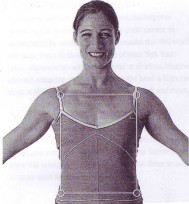
|
For many movement patterns (for example walking, running,
lifting, stair stepping, sitting at a computer and working a computer mouse),
the Box should be more or less square, neither shortening, nor rotating to one
side, either at rest or in movement. The Pilates Box can be a powerful therapeutic tool.
Two case studies follow.
Pilates Box Case Study 1: A man with shortening of the Pilates Box related
to the right shoulder and right hip.
Pictures: Front and Rear Views of a Man with shortening on the right hand side of the Pilates Box.
Note that the shortening has occurred both at the top (the right shoulder is dropped), and at
the bottom (the right hip is raised). The numbers refer to problem areas, a discussion of which now follows.
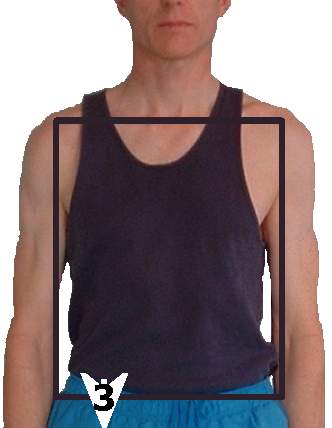

There are areas of concern:-
- The right upper trapezius is carrying some troublesome trigger points.
- The left mid-back occasionally suffers a twinge of pain.
- The right groin carries mild pain, the hip joint has a history of clunking,
and the hip flexors of the right hip are (despite training) somewhat
weak and prone to trigger point related pain.
Note that this man has regularly practiced Pilates mat for four years, and that all these
problems are less severe than they had been.
But let's discuss the problems.
1. The Painful Trapezius muscle.
The Problem:
The trigger points in this muscle send pain up into the right ear and face. He notes
that the pain is worse after intensive use of the computer mouse, and that he acknowledges
that he drops and tenses his right shoulder in an attempt
to keep the mouse movement accurate and efficient.
The Solution:
When sitting at the computer, square up the Pilates Box, relax the shoulders wide, and roll
the shoulder blades down. These are all exercise cues that a good
Pilates instructor will introduce during mat class.
2. The Twinge of Pain in the Left Mid-Back
The Problem:
The man recently noticed a twinge of pain after 70 minutes into a steep hill run.
Hill running involves a lot of hip flexor work. Let's take a look at what this man looks like
when mimicking the hip flexor work of hill running:-
Pilates Box analysis of man doing a standing straight leg raise.
(Note the shortening and forward twisting of the right hand side of the Pilates Box upon kicking the leg forward).
The Solution:
Adopt a running style that maintains the length of the right side of the body.
A subsequent 2 hour hill run did not cause any twinge of back pain, and running
times (especially the second half of the run) were improved.
This was an immediate solution, which did not require any stretching or
strengthening exercises, though the man
did note that it felt unnatural, and took considerable mental concentration.
3. The Right Groin and Hip Flexor Pain
The Problem:
An unstable hip joint! -
The right hip has tended to clunk (due to the head of the femur gliding forward in its socket -
according to Prof Shirley Sahrman this is an extremely common "movement impairment syndrome"- ref. 1).
The right hip flexors (Psoas and Iliacus) have responded by tensing up to guard
against joint damage, and are therefore carrying excessive tension at rest. The resultant trigger
points in these muscles
reduce their strength, flexibility and "trainability", and contribute to groin and back pain.
It has taken four years of
Pilates training combined with a precise stretching regime to train strength
and normal function back into these muscles. The hip clunk is reduced, but there
is still a small amount of groin pain.
The Pilates Box is shortening on the right because the painful hip flexor muscles
are "borrowing" some of the leg raising movement from the lower back.
The Solution:
Continue with hip flexor strengthening and flexibility, avoid the extremes of hip range of movement that
cause the femoral head to glide forward, (now that the hip joint is relatively normal)
keep the Pilates Box square!
Importantly: loosen the muscles behind the hip joint (the gluteal, or buttock muscles) with stretching and massage.
You can stretch the gluteals by deep squatting or doing the pilates rest position (child's pose in yoga).
or you can do a "knee to nipple stretch"!
The knee to nipple stretch...
Knee to nipple describes a shape in space - the same stretch can be performed seated or starting from quadruped.
Pictures: the seated knee to nipple stretch for gluteals is good.
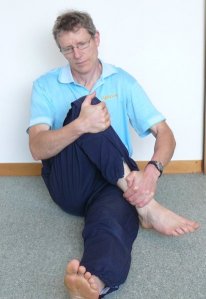
But the quadruped stretch is even better! -
Animation:
click to view!
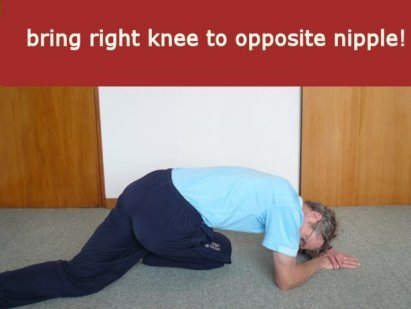
(Interested in avoiding harmful
hip joint movement patterns? -see especially this discussion:
The Golfers Swing as relates to Piriformis Pain
Note that all the below references are useful).
Pilates Box Case Study 2: Joseph Pilates
The photos below have been harvested from the web, and modified to assist in doing a Pilates
Box analysis of Joe Pilates himself.
(Special acknowledgement: Black and white pictures are by
I.C.Rapoport)
All of them show that Joe habitually carried his right shoulder low...

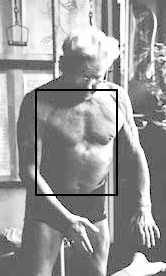
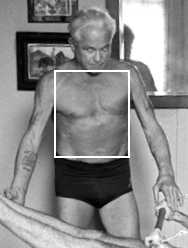
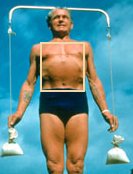
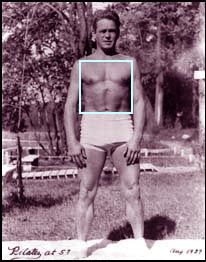
I have viewed other photographs, and they have so far confirmed the drop-shoulder observation.
Pilates lead a very active and exciting life. He took part in or taught (amongst other things)
circus acts, Boxing, skiing, and self defence (read the Pilates Bio).
It is quite conceivable that he had
sustained an injury such as a shoulder dislocation or a broken collar bone. Said Joe at age 86:-
"I must be right. Never an aspirin. Never injured a day in my life.
The whole country, the whole world, should be doing my exercises. They'd be happier."
Joseph's mother was a naturopath, and the Pilates exercise system has great potential for
injury prevention, so I believe the statement about the aspirin.
Speaking as a therapist however,
I take the comment "never an injury" with a grain of salt. People have a
selective memory when it comes to past illness and injury.
At any rate, I mean no disrespect to the
"drop shouldered" Joe Pilates, and I am sure that he had "fixed himself" to a level
where he was perfectly comfortable and functional whatever a Pilates Box Analysis may show.
Pilates Box References:
- Shirley A Sahrmann: Diagnosis and Treatment of Movement Impairment Syndromes; Publ. Mosby 2002
-
Bruce Thomson:
The Golfers Swing as relates to Piriformis pain.
See especially the Golfer's swing diagrams. The golfer with perfect form has maintained a more or less square Pilates Box
Note that the same movement patterns that promote Piriformis
muscle damage also encourage the femoral head to glide forward.
- Alicia Ungaro: Pilates body in Motion Publ. Dorling Kindersley
- Bruce Thomson: The Back Maintenance
Manual (1): Pilates Exercises for Low Back Pain
- Nicholas Romanov: The Pose Method of Running Publ. PoseTech Press 2002

Return to top...
The Pilates Box ©
© Bruce Thomson, EasyVigour Project

|
|
Joseph Pilates, age 59,
see a Pilates Box Analysis
applied to Joe Pilates...
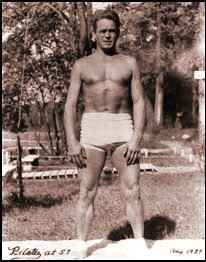
|
|
Purchase the Pilates Classics...
|